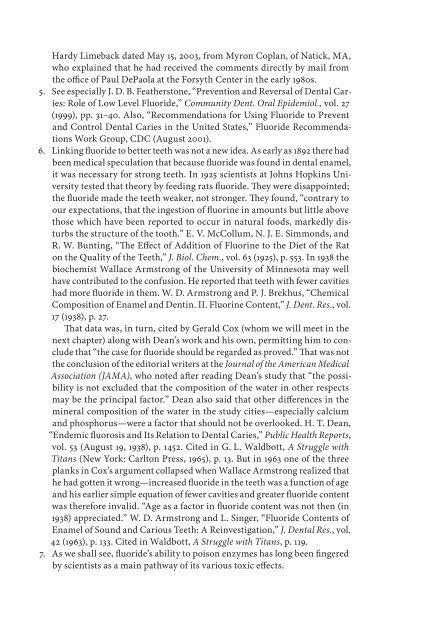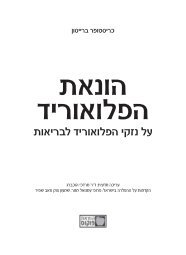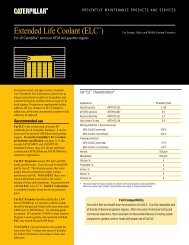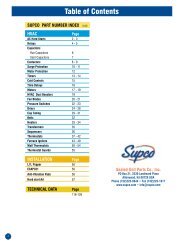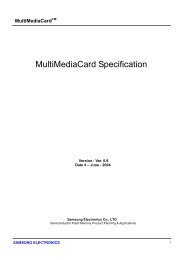Epigraphs Note on Terminology Acknowledgments Introduction
Epigraphs Note on Terminology Acknowledgments Introduction
Epigraphs Note on Terminology Acknowledgments Introduction
You also want an ePaper? Increase the reach of your titles
YUMPU automatically turns print PDFs into web optimized ePapers that Google loves.
Hardy Limeback dated May 15, 2003, from Myr<strong>on</strong> Coplan, of Natick, MA,<br />
who explained that he had received the comments directly by mail from<br />
the office of Paul DePaola at the Forsyth Center in the early 1980s.<br />
5. See especially J. D. B. Featherst<strong>on</strong>e, “Preventi<strong>on</strong> and Reversal of Dental Caries:<br />
Role of Low Level Fluoride,” Community Dent. Oral Epidemiol., vol. 27<br />
(1999), pp. 31–40. Also, “Recommendati<strong>on</strong>s for Using Fluoride to Prevent<br />
and C<strong>on</strong>trol Dental Caries in the United States,” Fluoride Recommendati<strong>on</strong>s<br />
Work Group, CDC (August 2001).<br />
6. Linking fluoride to better teeth was not a new idea. As early as 1892 there had<br />
been medical speculati<strong>on</strong> that because fluoride was found in dental enamel,<br />
it was necessary for str<strong>on</strong>g teeth. In 1925 scientists at Johns Hopkins University<br />
tested that theory by feeding rats fluoride. They were disappointed;<br />
the fluoride made the teeth weaker, not str<strong>on</strong>ger. They found, “c<strong>on</strong>trary to<br />
our expectati<strong>on</strong>s, that the ingesti<strong>on</strong> of fluorine in amounts but little above<br />
those which have been reported to occur in natural foods, markedly disturbs<br />
the structure of the tooth.” E. V. McCollum, N. J. E. Simm<strong>on</strong>ds, and<br />
R. W. Bunting, “The Effect of Additi<strong>on</strong> of Fluorine to the Diet of the Rat<br />
<strong>on</strong> the Quality of the Teeth,” J. Biol. Chem., vol. 63 (1925), p. 553. In 1938 the<br />
biochemist Wallace Armstr<strong>on</strong>g of the University of Minnesota may well<br />
have c<strong>on</strong>tributed to the c<strong>on</strong>fusi<strong>on</strong>. He reported that teeth with fewer cavities<br />
had more fluoride in them. W. D. Armstr<strong>on</strong>g and P. J. Brekhus, “Chemical<br />
Compositi<strong>on</strong> of Enamel and Dentin. II. Fluorine C<strong>on</strong>tent,” J. Dent. Res., vol.<br />
17 (1938), p. 27.<br />
That data was, in turn, cited by Gerald Cox (whom we will meet in the<br />
next chapter) al<strong>on</strong>g with Dean’s work and his own, permitting him to c<strong>on</strong>clude<br />
that “the case for fluoride should be regarded as proved.” That was not<br />
the c<strong>on</strong>clusi<strong>on</strong> of the editorial writers at the Journal of the American Medical<br />
Associati<strong>on</strong> (JAMA), who noted after reading Dean’s study that “the possibility<br />
is not excluded that the compositi<strong>on</strong> of the water in other respects<br />
may be the principal factor.” Dean also said that other differences in the<br />
mineral compositi<strong>on</strong> of the water in the study cities—especially calcium<br />
and phosphorus—were a factor that should not be overlooked. H. T. Dean,<br />
“Endemic fluorosis and Its Relati<strong>on</strong> to Dental Caries,” Public Health Reports,<br />
vol. 53 (August 19, 1938), p. 1452. Cited in G. L. Waldbott, A Struggle with<br />
Titans (New York: Carlt<strong>on</strong> Press, 1965), p. 13. But in 1963 <strong>on</strong>e of the three<br />
planks in Cox’s argument collapsed when Wallace Armstr<strong>on</strong>g realized that<br />
he had gotten it wr<strong>on</strong>g—increased fluoride in the teeth was a functi<strong>on</strong> of age<br />
and his earlier simple equati<strong>on</strong> of fewer cavities and greater fluoride c<strong>on</strong>tent<br />
was therefore invalid. “Age as a factor in fluoride c<strong>on</strong>tent was not then (in<br />
1938) appreciated.” W. D. Armstr<strong>on</strong>g and L. Singer, “Fluoride C<strong>on</strong>tents of<br />
Enamel of Sound and Carious Teeth: A Reinvestigati<strong>on</strong>,” J. Dental Res., vol.<br />
42 (1963), p. 133. Cited in Waldbott, A Struggle with Titans, p. 119.<br />
7. As we shall see, fluoride’s ability to pois<strong>on</strong> enzymes has l<strong>on</strong>g been fingered<br />
by scientists as a main pathway of its various toxic effects.


